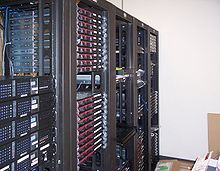Web hosting service

| Part of a series on |
| Internet hosting service |
|---|
| Full-featured hosting |
| Web hosting |
| Application-specific web hosting |
| By content format |
| Other types |
This article may need to be rewritten to comply with Wikipedia's quality standards. (February 2016) |
A web hosting service is a type of Internet hosting service that allows individuals and organizations to make their website accessible via the World Wide Web. Web hosts are companies that provide space on a server owned or leased for use by clients, as well as providing Internet connectivity, typically in a data center. Web hosts can also provide data center space and connectivity to the Internet for other servers located in their data center, called colocation, also known as Housing in Latin America or France.
Types of hosting

Internet hosting services can run Web servers. The scope of web hosting services varies greatly.
Smaller hosting services
The most basic is web page and small-scale file hosting, where files can be uploaded via File Transfer Protocol (FTP) or a Web interface. The files are usually delivered to the Web "as is" or with minimal processing. Many Internet service providers (ISPs) offer this service free to subscribers. Individuals and organizations may also obtain Web page hosting from alternative service providers.
Free web hosting service is offered by different companies with limited services, sometimes supported by advertisements, and often limited when compared to paid hosting.
Single page hosting is generally sufficient for personal web pages. Personal web site hosting is typically free, advertisement-sponsored, or inexpensive. Business web site hosting often has a higher expense depending upon the size and type of the site.
Larger hosting services
Many large companies that are not Internet service providers need to be permanently connected to the web to send email, files, etc. to other sites. The company may use the computer as a website host to provide details of their goods and services and facilities for online orders.
A complex site calls for a more comprehensive package that provides database support and application development platforms (e.g. ASP.NET, ColdFusion, Java EE, Perl/Plack, PHP or Ruby on Rails). These facilities allow customers to write or install scripts for applications like forums and content management. Also, Secure Sockets Layer (SSL) is typically used for websites that wish to keep the data transmitted more secure.
- Shared web hosting service: one's website is placed on the same server as many other sites, ranging from a few sites to hundreds of websites. Typically, all domains may share a common pool of server resources, such as RAM and the CPU. The features available with this type of service can be quite basic and not flexible in terms of software and updates. Resellers often sell shared web hosting and web companies often have reseller accounts to provide hosting for clients.
- Reseller web hosting: allows clients to become web hosts themselves. Resellers could function, for individual domains, under any combination of these listed types of hosting, depending on who they are affiliated with as a reseller. Resellers' accounts may vary tremendously in size: they may have their own virtual dedicated server to a colocated server. Many resellers provide a nearly identical service to their provider's shared hosting plan and provide the technical support themselves.
- Virtual Dedicated Server: also known as a Virtual Private Server (VPS), divides server resources into virtual servers, where resources can be allocated in a way that does not directly reflect the underlying hardware. VPS will often be allocated resources based on a one server to many VPSs relationship, however virtualisation may be done for a number of reasons, including the ability to move a VPS container between servers. The users may have root access to their own virtual space. Customers are sometimes responsible for patching and maintaining the server (unmanaged server) or the VPS provider may provide server admin tasks for the customer (managed server).
- Dedicated hosting service: the user gets his or her own Web server and gains full control over it (user has root access for Linux/administrator access for Windows); however, the user typically does not own the server. One type of dedicated hosting is self-managed or unmanaged. This is usually the least expensive for dedicated plans. The user has full administrative access to the server, which means the client is responsible for the security and maintenance of his own dedicated server.
- Managed hosting service: the user gets his or her own Web server but is not allowed full control over it (user is denied root access for Linux/administrator access for Windows); however, they are allowed to manage their data via FTP or other remote management tools. The user is disallowed full control so that the provider can guarantee quality of service by not allowing the user to modify the server or potentially create configuration problems. The user typically does not own the server. The server is leased to the client.
- Colocation web hosting service: similar to the dedicated web hosting service, but the user owns the colo server; the hosting company provides physical space that the server takes up and takes care of the server. This is the most powerful and expensive type of web hosting service. In most cases, the colocation provider may provide little to no support directly for their client's machine, providing only the electrical, Internet access, and storage facilities for the server. In most cases for colo, the client would have his own administrator visit the data center on site to do any hardware upgrades or changes. Formerly, many colocation providers would accept any system configuration for hosting, even ones housed in desktop-style minitower cases, but most hosts now require rack mount enclosures and standard system configurations.
- Cloud hosting: is a new type of hosting platform that allows customers powerful, scalable and reliable hosting based on clustered load-balanced servers and utility billing. A cloud hosted website may be more reliable than alternatives since other computers in the cloud can compensate when a single piece of hardware goes down. Also, local power disruptions or even natural disasters are less problematic for cloud hosted sites, as cloud hosting is decentralized. Cloud hosting also allows providers to charge users only for resources consumed by the user, rather than a flat fee for the amount the user expects they will use, or a fixed cost upfront hardware investment. Alternatively, the lack of centralization may give users less control on where their data is located which could be a problem for users with data security or privacy concerns.
- Clustered hosting: having multiple servers hosting the same content for better resource utilization. Clustered servers are a perfect solution for high-availability dedicated hosting, or creating a scalable web hosting solution. A cluster may separate web serving from database hosting capability. (Usually web hosts use clustered hosting for their shared hosting plans, as there are multiple benefits to the mass managing of clients).[1]
- Grid hosting: this form of distributed hosting is when a server cluster acts like a grid and is composed of multiple nodes.
- Home server: usually a single machine placed in a private residence can be used to host one or more web sites from a usually consumer-grade broadband connection. These can be purpose-built machines or more commonly old PCs. Some ISPs actively attempt to block home servers by disallowing incoming requests to TCP port 80 of the user's connection and by refusing to provide static IP addresses. A common way to attain a reliable DNS host name is by creating an account with a dynamic DNS service. A dynamic DNS service will automatically change the IP address that a URL points to when the IP address changes.[2]
Some specific types of hosting provided by web host service providers:
- File hosting service: hosts files, not web pages
- Image hosting service
- Video hosting service
- Blog hosting service
- Paste bin
- Shopping cart software
- E-mail hosting service
Host management

The host may also provide an interface or control panel for managing the Web server and installing scripts, as well as other modules and service applications like e-mail. A web server that does not use a control panel for managing the hosting account, is often referred to as a "headless" server. Some hosts specialize in certain software or services (e.g. e-commerce, blogs, etc.).
Reliability and uptime
The availability of a website is measured by the percentage of a year in which the website is publicly accessible and reachable via the Internet. This is different from measuring the uptime of a system. Uptime refers to the system itself being online. Uptime does not take into account being able to reach it as in the event of a network outage.[citation needed] A hosting provider’s Service Level Agreement (SLA) may include a certain amount of scheduled downtime per year in order to perform maintenance on the systems. This scheduled downtime is often excluded from the SLA timeframe, and needs to be subtracted from the Total Time when availability is calculated. Depending on the wording of an SLA, if the availability of a system drops below that in the signed SLA, a hosting provider often will provide a partial refund for time lost. How downtime is determined changes from provider to provider, therefore reading the SLA is imperative.[3] Not all providers release uptime statistics.[4] Most hosting providers will guarantee at least 99.9% uptime which will allow for 43m of downtime per month, or 8h 45m of downtime per year.
Obtaining hosting
Web hosting is often provided as part of a general Internet access plan from Internet service providers. There are also many free and paid providers offering web hosting.
A customer needs to evaluate the requirements of the application to choose what kind of hosting to use. Such considerations include database server software, scripting software, and operating system. Most hosting providers provide Linux-based web hosting which offers a wide range of different software. A typical configuration for a Linux server is the LAMP platform: Linux, Apache, MySQL, and PHP/Perl/Python. The web hosting client may want to have other services, such as email for their business domain, databases or multimedia services. A customer may also choose Windows as the hosting platform. The customer still can choose from Perl, PHP, Python and Ruby but may also use ASP .Net or Classic ASP. Web hosting packages often include a Web Content Management System, so the end-user does not have to worry about the more technical aspects.
See also
- Cloud hosting
- Comparison of free web hosting services
- Dedicated hosting service
- Green hosting
- Shared hosting
References
- ^ Buyya, R.; Yeo, Chee Shin; Venugopal, S. (September 2008). "Market-Oriented Cloud Computing: Vision, Hype, and Reality for Delivering IT Services as Computing Utilities". 10th IEEE International Conference on High Performance Computing and Communications, 2008. HPCC '08: 5–13. doi:10.1109/HPCC.2008.172.
- ^ Han, I.; Park, Hong-Shik; Jeong, Youn-Kwae; Park, Kwang-Roh (February 2006). "An integrated home server for communication, broadcast reception, and home automation". IEEE Transactions on Consumer Electronics. 52 (1): 104–109. doi:10.1109/TCE.2006.1605033. ISSN 0098-3063.
- ^ Dawson, Christian. "Why Uptime Guarantees are Ridiculous". Servint. Retrieved 7 October 2014.
a good SLA will clearly state how uptime is defined and what you'll receive if the "uptime promise" is not met.
- ^ Vanvleet, Derek. "Google Apps vs. Office 365: What Does 99.9% Uptime Really Mean?". Cloud Sherpas. Retrieved 7 October 2014.
External links
